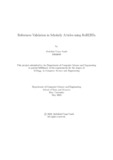| dc.contributor.advisor | Alam, Md. Golam Rabiul | |
| dc.contributor.author | Nasib, Abdullah Umar | |
| dc.date.accessioned | 2023-09-25T06:25:45Z | |
| dc.date.available | 2023-09-25T06:25:45Z | |
| dc.date.copyright | 2023 | |
| dc.date.issued | 2023-05 | |
| dc.identifier.other | ID 19166009 | |
| dc.identifier.uri | http://hdl.handle.net/10361/21226 | |
| dc.description | This project report is submitted in partial fulfillment of the requirements for the degree of Master of Science in Computer Science and Engineering, 2023. | en_US |
| dc.description | Cataloged from the PDF version of the project report. | |
| dc.description | Includes bibliographical references (pages 36-37). | |
| dc.description.abstract | In the recent era of technological advancement, evaluating references and assignments and validating those are some of the primary processes to justify the authenticity of a research work in the academic sector. The purpose of referencing
is to ensure ethical writing and to make the search easier in a particular area for
the reader when it is accurate. The traditional way to cross-check the validations
is to check them manually one by one, which is above argument, equivalent to an-
other work, and sometimes so tiring that the reader loses interest in reading the
original paper. The target of this research paper is to introduce a semi-automatic
digital system that enables researchers to justify the references used in a research
paper without doing it manually. In this model, we have prepared a sentence trans-
former named RoBERTa for generating embedding. We sanitize and preprocess
an entire research paper and cross-match that against a reference query using the
proposed model in terms of finding semantic and contextual similarity. The result
shows mostly similar contexts based on the similarity check. We have compared
the embedding of query and user input articles with the help of K similar search
function. Our model outperformed the existing BERT and SBERT models’ output
in accuracy with a F1 score of 0.777, which establishes the fact that the model can
be used in real life with a simple query of text from research articles. | en_US |
| dc.description.statementofresponsibility | Abdullah Umar Nasib | |
| dc.format.extent | 47 pages | |
| dc.language.iso | en | en_US |
| dc.publisher | Brac University | en_US |
| dc.rights | Brac University project reports are protected by copyright. They may be viewed from this source for any purpose, but reproduction or distribution in any format is prohibited without written permission. | |
| dc.subject | Reference validation | en_US |
| dc.subject | Semantic similarity analysis | en_US |
| dc.subject | Contextual similarity analysis | en_US |
| dc.subject | RoBERTa | en_US |
| dc.subject | K similar search | en_US |
| dc.subject | Natural language processing | en_US |
| dc.subject.lcsh | Natural language processing (Computer science) | |
| dc.title | References validation in scholarly articles using RoBERTa | en_US |
| dc.type | Project report | en_US |
| dc.contributor.department | Department of Computer Science and Engineering, Brac University | |
| dc.description.degree | M. Computer Science and Engineering | |

